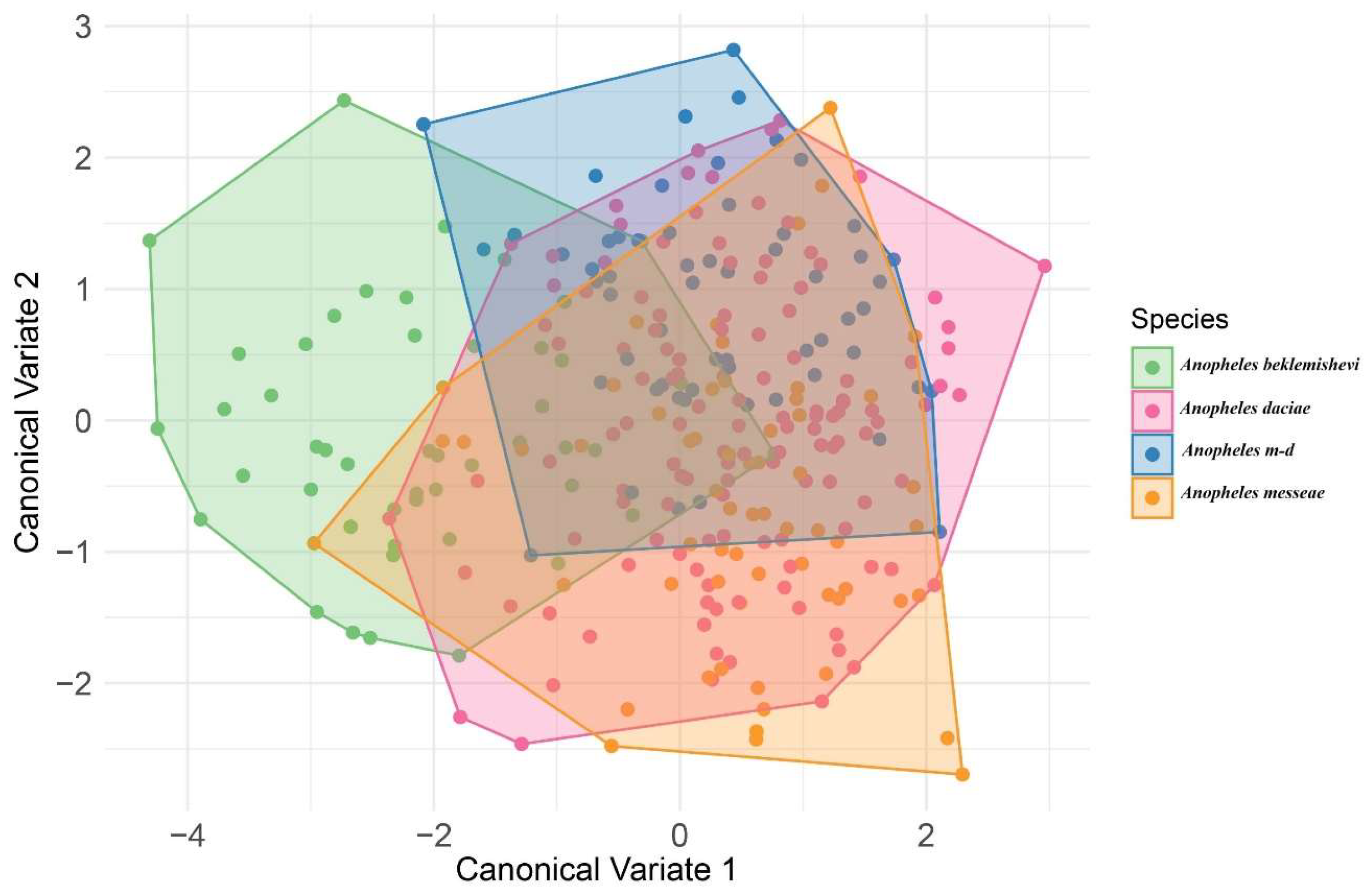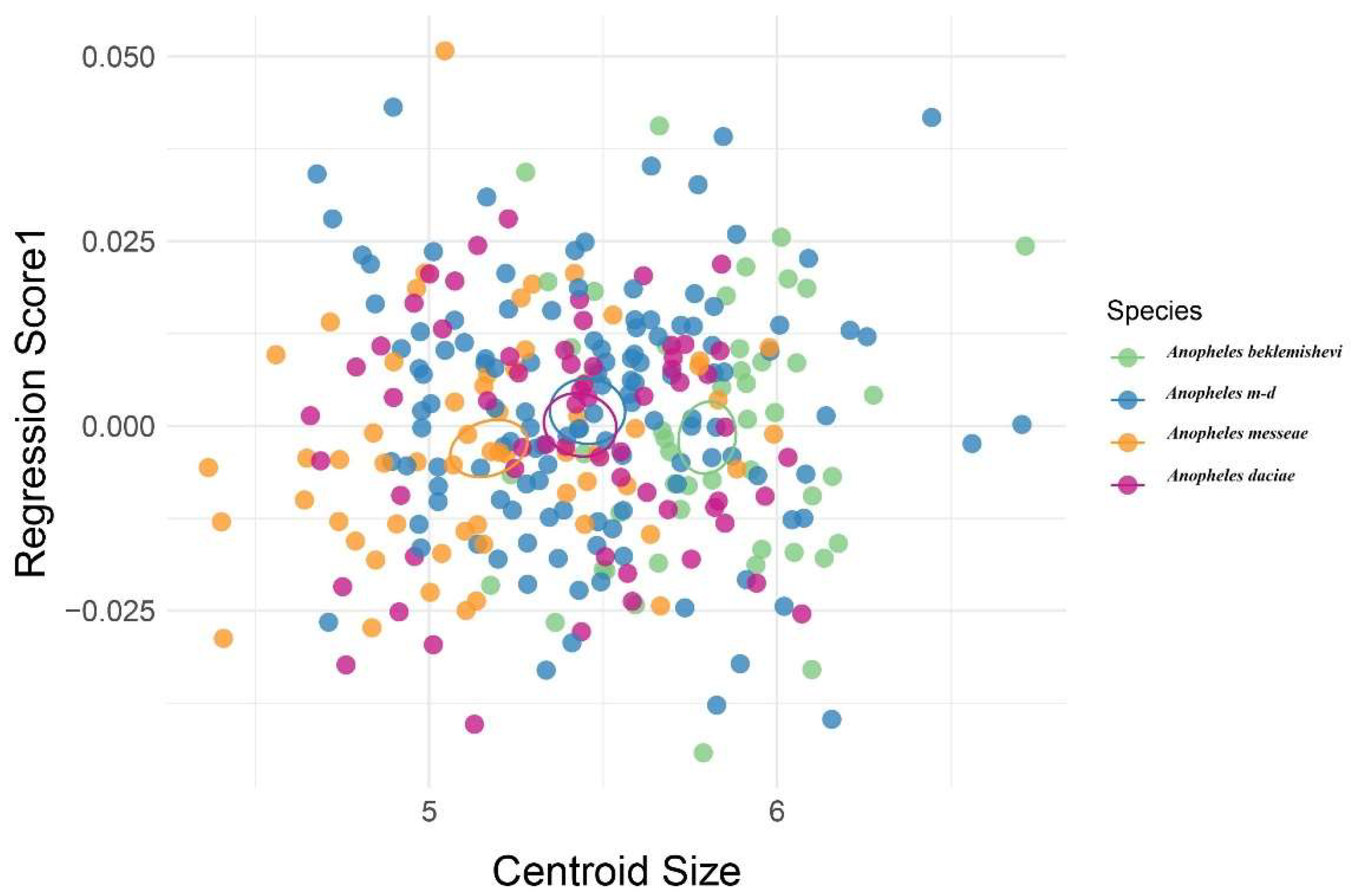Unraveling Wing Shape Variation in Malaria Mosquitoes from the Arctic Edge: A Geometric Morphometric Study in Western Siberia
Abstract
Simple Summary
Abstract
1. Introduction
2. Materials and Methods
2.1. Study Area and Sampling Sites
2.2. Wing Preparation and Landmark Digitization
2.3. Geometric Morphometric and Statistical Analysis
3. Results
3.1. Geographical Distribution of Anopheles Species
3.2. Statistical Analysis
4. Discussion
5. Conclusions
Supplementary Materials
Author Contributions
Funding
Institutional Review Board Statement
Informed Consent Statement
Data Availability Statement
Acknowledgments
Conflicts of Interest
References
- WHO, World Health Organization. World Malaria Report 2023; World Health Organization: Geneva, Switzerland, 2023; Available online: https://www.who.int/teams/global-malaria-programme/reports/world-malaria-report-2023 (accessed on 13 January 2025).
- Artemov, G.N.; Gordeev, M.I.; Kokhanenko, A.A.; Moskaev, A.V.; Velichevskaya, A.I.; Stegniy, V.N.; Sharakhov, I.V.; Sharakhova, M.V. A standard photomap of ovarian nurse cell chromosomes and inversion polymorphism in Anopheles beklemishevi. Parasites Vectors 2018, 11, 684. [Google Scholar] [CrossRef]
- Brusentsov, I.I.; Gordeev, M.I.; Yurchenko, A.A.; Karagodin, D.A.; Moskaev, A.V.; Hodge, J.M.; Burlak, V.A.; Artemov, G.N.; Sibataev, A.K.; Becker, N.; et al. Patterns of genetic differentiation imply distinct phylogeographic history of the mosquito species Anopheles messeae and Anopheles daciae in Eurasia. Mol. Ecol. 2023, 32, 5609–5625. [Google Scholar] [CrossRef] [PubMed]
- Poltoratskaya, N.V.; Pankina, T.M.; Burlak, V.A.; Fedorova, V.S.; Katokhin, A.V.; Poltoratskaya, T.N.; Artemov, G.N.; Shikhin, A.V. On the infection of blood-sucking mosquitoes with Dirofilaria (Dirofilaria Railliet et Henry, 1911) in the Tomsk region. Med. Parasitol. Parasit. Dis. 2021, 1, 21–28. [Google Scholar] [CrossRef]
- Stegnii, V.N.; Sharakhova, M.V. Systemic reorganization of the architechtonics of polytene chromosomes in onto- and phylogenesis of malaria mosquitoes. Structural features regional of chromosomal adhesion to the nuclear membrane. Genetika 1991, 27, 828–835. [Google Scholar] [PubMed]
- Stegniy, V.N. Arkhitektonika Genoma, Sistemnye Mutatsii i Evolyutsiya (Genome Architecture, Systemic Mutations, and Evolution); Novosibirsk Novosibirsk State University: Novosibirsk, Russia, 1993. [Google Scholar]
- Sharakhova, M.V.; Stegnii, V.N.; Timofeeva, O.V. Pericentromeric heterochromatin polymorphism in polytene chromosomes of ovarian trophocytes in natural populations of the malaria mosquito Anopheles messeae Fall. Russ. J. Genet. 1997, 33, 220–222. [Google Scholar]
- Novikov, Y.M. Anopheles messeae Fall. (Diptera, Culicidae)—Two species in statu nascendi. In Macroevolution (Materials of the 1st All-USSR Conference on Evolutionary Problems); Nauka Publishers: Moscow, Russia, 1984; pp. 13–14. (In Russian) [Google Scholar]
- Novikov, Y.M.; Shevchenko, A.I. Inversion polymorphism and the divergence of two cryptic forms of Anopheles messeae (Diptera, Culicidae) at the level of genomic DNA repeats. Genetika 2001, 37, 915–925. [Google Scholar] [CrossRef] [PubMed]
- Nicolescu, G.; Linton, Y.-M.; Vladimirescu, A.; Howard, T.M.; Harbach, R.E. Mosquitoes of the Anopheles maculipennis group (Diptera: Culicidae) in Romania, with the discovery and formal recognition of a new species based on molecular and morphological evidence. Bull. Entomol. Res. 2004, 94, 525–535. [Google Scholar] [CrossRef]
- Naumenko, A.N.; Karagodin, D.A.; Yurchenko, A.A.; Moskaev, A.V.; Martin, O.I.; Baricheva, E.M.; Sharakhov, I.V.; Gordeev, M.I.; Sharakhova, M.V. Chromosome and genome divergence between the cryptic Eurasian malaria vector-species Anopheles messeae and Anopheles daciae. Genes 2020, 11, 165. [Google Scholar] [CrossRef]
- Benítez, H.; Parra, L.E.; Sepulveda, E.; Sanzana, M.J. Geometric perspectives of sexual dimorphism in the wing shape of Lepidoptera: The case of Synneuria sp. (Lepidoptera: Geometridae). J. Entomol. Res. Soc. 2011, 13, 53–60. [Google Scholar]
- Sendaydiego, J.P.; Torres, M.A.J.; Demayo, C.G. Describing wing geometry of Aedes aegypti using landmark-based geometric morphometrics. Int. J. Biosci. Biochem. Bioinform. 2013, 3, 379. [Google Scholar]
- Pereira-da-Conceicoa, L.L.; Benítez, H.A.; Barber-James, H.M. Disentangling wing shape evolution in the African mayfly, Teloganodidae (Ephemeroptera). Zool. Anz. 2019, 280, 30–41. [Google Scholar] [CrossRef]
- Klingenberg, C.P. Evolution and development of shape: Integrating quantitative approaches. Nat. Rev. Genet. 2010, 11, 623–635. [Google Scholar] [CrossRef]
- Villalobos-Leiva, A.; Benítez, H.A. Morfometría geométrica y sus nuevas aplicaciones en ecología y biología evolutiva. Parte 2. Int. J. Morphol. 2020, 38, 1818–1836. [Google Scholar] [CrossRef]
- Lorenz, C.; Almeida, F.; Almeida-Lopes, F.; Louise, C.; Pereira, S.N.; Petersen, V.; Vidal, P.O.; Virginio, F.; Suesdek, L. Geometric morphometrics in mosquitoes: What has been measured? Infect. Genet. Evol. 2017, 54, 205–215. [Google Scholar] [CrossRef]
- Jeon, J.; Kim, H.C.; Klein, T.A.; Choi, K.S. Analysis of geometric morphometrics and molecular phylogeny for Anopheles species in the Republic of Korea. Sci. Rep. 2023, 13, 22009. [Google Scholar] [CrossRef]
- Bellin, N.; Calzolari, M.; Callegari, E.; Bonilauri, P.; Grisendi, A.; Dottori, M.; Rossi, V. Geometric morphometrics and machine learning as tools for the identification of sibling mosquito species of the Maculipennis complex (Anopheles). Infect. Genet. Evol. 2021, 95, 105029. [Google Scholar] [CrossRef]
- Ayala, D.; Caro-Riaño, H.; Dujardin, J.-P.; Rahola, N.; Simard, F.; Fontenille, D. Chromosomal and environmental determinants of morphometric variation in natural populations of the malaria vector Anopheles funestus in Cameroon. Infect. Genet. Evol. 2011, 11, 940–947. [Google Scholar] [CrossRef]
- Gómez, G.F.; Márquez, E.J.; Gutiérrez, L.A.; Conn, J.E.; Correa, M.M. Geometric morphometric analysis of Colombian Anopheles albimanus (Diptera: Culicidae) reveals significant effect of environmental factors on wing traits and presence of a metapopulation. Acta Trop. 2014, 135, 75–85. [Google Scholar] [CrossRef]
- Klingenberg, C.P. MorphoJ: An integrated software package for geometric morphometrics. Mol. Ecol. Resour. 2011, 11, 353–357. [Google Scholar] [CrossRef] [PubMed]
- Alvial, I.E.; Hernández, P.R.; Suazo, M.J.; González, C.R.; Véliz, D.; Benítez, H.A. Unraveling biotypes of the northern house mosquito, Culex pipiens s.l. (Diptera: Culicidae): Molecular differentiation and morphometric analysis. J. Insect Sci. 2024, 24, 7. [Google Scholar] [CrossRef]
- Artemov, G.N.; Fedorova, V.S.; Karagodin, D.A.; Brusentsov, I.I.; Baricheva, E.M.; Sharakhov, I.V.; Gordeev, M.I.; Sharakhova, M.V. New cytogenetic photomap and molecular diagnostics for the cryptic species of the malaria mosquitoes Anopheles messeae and Anopheles daciae from Eurasia. Insects 2021, 12, 793. [Google Scholar] [CrossRef]
- Pogoda i Klimat. Weather and Climate Database of Russia. 2021. Available online: https://pogodaiklimat.ru (accessed on 13 January 2025).
- Yakimenko, V.V.; Malkova, M.G.; Shpynov, S.N. Ixodid Ticks of Western Siberia: Fauna, Ecology, Main Research Methods; Omsk Scientific Bulletin Publishing House: Omsk, Russia, 2013; ISBN 978-591306-051-8. (In Russian) [Google Scholar]
- Rohlf, F.J. The tps series of software. Hystrix 2015, 26, 9–12. [Google Scholar]
- Rohlf, F.J.; Slice, D. Extensions of the Procrustes methods for the optimal superimposition of landmarks. Syst. Zool. 1990, 39, 40–59. [Google Scholar] [CrossRef]
- Adams, D.C.; Otárola-Castillo, E. geomorph: An R package for the collection and analysis of geometric morphometric shape data. Methods Ecol. Evol. 2013, 4, 393–399. [Google Scholar] [CrossRef]
- Wickham, H. Data analysis. In ggplot2: Elegant Graphics for Data Analysis; Springer International Publishing: Cham, Switzerland, 2016; pp. 189–201. [Google Scholar]
- RStudio Team. RStudio: Integrated Development for, R; RStudio, PBC: Boston, MA, USA, 2020. [Google Scholar]






| Locality | Subzone | Province | Altitude (m) | Population | Main Water Body |
|---|---|---|---|---|---|
| Berezovo | Northern taiga | Severo-Sosvinskaya | 31 | 6411 | Vogulka, Ob |
| Bolshaya Sarovka | Southern taiga | Chulymo-Yeniseyskaya | 72 | 552 | Sarovka, Ob |
| Kolarovo | Birch–aspen forest | Chulymo-Yeniseyskaya | 86 | 376 | Tom river |
| Kropani | Northern forest-steppe | Zauralskaya | 84 | 621 | Tobol river, lakes |
| Novoaltaysk | Piedmont forest-steppe | Verkhneobskaya | 140 | 73,511 | Chesnokovka, wetlands |
| Bystryanka | Mountain forest belt | Verkhneobskaya | 222 | 1838 | Katun river |
| Locality | Breeding Season | Duration (Days) | Mean Temp (°C) | Precipitation (mm) | Precip. Rate (mm/Day) | Heat Sum (°C) | Tgtz | Fgtz | Egtz |
|---|---|---|---|---|---|---|---|---|---|
| Berezovo | 9 May–5 September | 120 | 13.9 | 240.9 | 2.01 | 545.2 | 14.9 | 13 | 9–10 |
| Bolshaya Sarovka | 3 May–28 August | 118 | 14.9 | 228.3 | 1.93 | 624.0 | 17.1 | 15 | 10–11 |
| Kolarovo | 3 May–16 September | 137 | 15.5 | 254.2 | 1.86 | 795.3 | 21.8 | 19 | 14–15 |
| Kropani | 2 May–16 September | 138 | 18.9 | 135.2 | 0.98 | 1246.2 | 34.1 | 30 | 25–26 |
| Novoaltaysk | 27 April–19 September | 146 | 17.1 | 181.1 | 1.24 | 1061.6 | 29.1 | 25 | 20–21 |
| Bystryanka | 27 April–19 September | 146 | 17.0 | 154.4 | 1.06 | 1053.6 | 28.9 | 25 | 20–21 |
| Centroid Size | |||||
|---|---|---|---|---|---|
| Effect | SS | MS | df | p (param.) | |
| Individual | 93.44285 | 0.348667 | 268 | 8.72 | <0.0001 |
| Error 1 | 10.71869 | 0.039995 | 268 | ||
| Shape | |||||
| Effect | SS | MS | df | F | p (param.) |
| Individual | 0.756514 | 8.3 × 10−5 | 9112 | 8.57 | <0.0001 |
| Error 1 | 0.088315 | 9.69 × 10−6 | 9112 | ||
| Centroid Size | |||||||
|---|---|---|---|---|---|---|---|
| Effect | SS | MS | df | F | p (param.) | ||
| Species | 10.52242 | 3.507474 | 3 | 23.71 | <0.0001 | ||
| Locality | 1.810702 | 0.36214 | 5 | 2.45 | 0.0344 | ||
| Individual | 38.01389 | 0.147914 | 257 | 3.12 | 0.0003 | ||
| Residual | 1.375043 | 0.047415 | 29 | ||||
| Shape | |||||||
| Effect | SS | MS | df | F | p (param.) | Pillai tr. | p (param.) |
| Species | 0.012278 | 0.000120372 | 102 | 3.07 | <0.0001 | 0.94 | <0.0001 |
| Locality | 0.008863 | 5.21366 × 10−5 | 170 | 1.33 | 0.0028 | 0.78 | 0.0318 |
| Individual | 0.342447 | 3.91905 × 10−5 | 8738 | 4.38 | <0.0001 | ||
| Residual | 0.008832 | 8.9578 × 10−6 | 986 | ||||
Disclaimer/Publisher’s Note: The statements, opinions and data contained in all publications are solely those of the individual author(s) and contributor(s) and not of MDPI and/or the editor(s). MDPI and/or the editor(s) disclaim responsibility for any injury to people or property resulting from any ideas, methods, instructions or products referred to in the content. |
© 2025 by the authors. Licensee MDPI, Basel, Switzerland. This article is an open access article distributed under the terms and conditions of the Creative Commons Attribution (CC BY) license (https://creativecommons.org/licenses/by/4.0/).
Share and Cite
Calderon, X.; Artemov, G.; Burlak, V.A.; Alexeeva, S.; Hernández-P, R.; Suazo, M.J.; Pérez, L.M.; Benítez, H.A.; Correa, M. Unraveling Wing Shape Variation in Malaria Mosquitoes from the Arctic Edge: A Geometric Morphometric Study in Western Siberia. Animals 2025, 15, 2949. https://doi.org/10.3390/ani15202949
Calderon X, Artemov G, Burlak VA, Alexeeva S, Hernández-P R, Suazo MJ, Pérez LM, Benítez HA, Correa M. Unraveling Wing Shape Variation in Malaria Mosquitoes from the Arctic Edge: A Geometric Morphometric Study in Western Siberia. Animals. 2025; 15(20):2949. https://doi.org/10.3390/ani15202949
Chicago/Turabian StyleCalderon, Ximena, Gleb Artemov, Vladimir A. Burlak, Svetlana Alexeeva, Raquel Hernández-P, Manuel J. Suazo, Laura M. Pérez, Hugo A. Benítez, and Margarita Correa. 2025. "Unraveling Wing Shape Variation in Malaria Mosquitoes from the Arctic Edge: A Geometric Morphometric Study in Western Siberia" Animals 15, no. 20: 2949. https://doi.org/10.3390/ani15202949
APA StyleCalderon, X., Artemov, G., Burlak, V. A., Alexeeva, S., Hernández-P, R., Suazo, M. J., Pérez, L. M., Benítez, H. A., & Correa, M. (2025). Unraveling Wing Shape Variation in Malaria Mosquitoes from the Arctic Edge: A Geometric Morphometric Study in Western Siberia. Animals, 15(20), 2949. https://doi.org/10.3390/ani15202949







